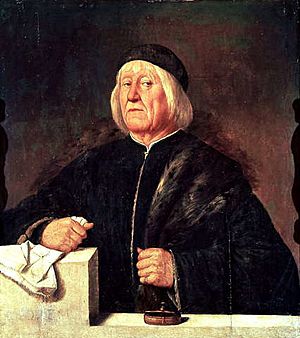Teofilo Folengo facts for kids
Quick facts for kids
Teofilo Folengo
|
|
|---|---|

Portrait of Teofilo Folengo by Romanino
|
|
| Born |
Girolamo Folengo
8 November 1491 Mantua, Margraviate of Mantua
|
| Died | 9 December 1544 (aged 53) Campese, Republic of Venice
|
| Resting place | Chiesa della Santa Croce (Campese) |
| Other names | Merlino Coccajo Merlinus Cocaius |
| Occupation |
|
| Parent(s) | Federico Folengo and Paola Folengo (née Ghisi) |
| Writing career | |
| Language | Italian, Latin |
| Genre |
|
| Literary movement | Italian Renaissance |
| Notable works | Opus macaronicum Baldus Orlandino |
Teofilo Folengo was an Italian poet who lived from 1491 to 1544. He was known for his unique style of writing called macaronic poetry. He often used the pen name Merlino Coccajo or Merlinus Cocaius when he wrote.
Contents
About Teofilo Folengo
Teofilo Folengo was born in a noble family in a place called Cipada, near Mantua, Italy. Even when he was very young, he showed a lot of energy and was very good at writing poems.
Becoming a Monk
When he was 16, Teofilo joined a monastery called Sant'Eufemia, near Brescia. About 18 months later, he officially became a member of the Benedictine order of monks. For a few years, he lived a regular life as a monk. During this time, he wrote many poems in Latin, trying to write like the famous Roman poet Virgil.
Life Outside the Monastery
Around 1516, Teofilo left the monastery for a while. He traveled around the country with a young woman named Girolama Dieda. They often struggled and had very little money, relying on his writing skills to get by.
Later in his life, Teofilo decided to return to the Church. He spent four years living alone as a hermit, doing penance. In 1534, he was allowed back into the Benedictine order.
Later Years
In 1538, Teofilo was sent to Sicily, near Palermo, with other monks from Mantua. He spent some of his later years there, supported by Ferrante Gonzaga. Gonzaga was a powerful leader who worked for Emperor Charles V as the Viceroy of Sicily.
Teofilo likely stayed at the abbey of San Martino delle Scale in Monreale. In 1543, he moved to the Santa Croce monastery in Campese, near Bassano. He passed away there on December 9, 1544.
His Famous Books
Teofilo Folengo's first major work was a long poem called Baldo (published in 1517). He wrote it using his Latin pen name, Merlinus Cocaius. This poem is a "macaronic" story, which means it mixes Latin words with words from different Italian dialects. It's written in a special poetic style called hexameter verse.
The Adventures of Baldo
The poem Baldo tells the exciting adventures of a made-up hero named Baldo. Baldo was a descendant of French royalty, but he was also a bit of a troublemaker when he was young. His adventures include being put in prison, fighting with local authorities, pirates, shepherds, witches, and even demons! He also takes a journey to the underworld.
Baldo is not alone in his adventures. He has several friends, including a giant, a centaur (a creature that is half-human, half-horse), a magician, and his best friend Cingar, who is a trickster. Even though the poem was sometimes criticized, it became very popular quickly. Many copies were printed, and Folengo later made the poem even longer.
Other Important Works
Folengo's next important work was Orlandino, an Italian poem with eight parts called cantos. It was written in a rhyming style called octaves. This poem came out in 1526, and on its cover, Folengo used a new pen name: Limerno Pitocco (which means Merlin the Beggar) da Mantova.
In the same year, after being tired of a life of wandering, Folengo returned to his religious life. Soon after, he wrote Caos del tri per uno. In this work, he used a mix of prose (like regular writing) and verse (poetry), and sometimes Latin, sometimes Italian, and sometimes macaronic language. In it, he hinted at the many changes and events in his life under his different names.
See also
 In Spanish: Teófilo Folengo para niños
In Spanish: Teófilo Folengo para niños


